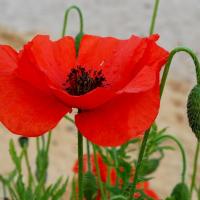Common poppy
Papaver rhoeas
Introduction: Papaver rhoeas, commonly known as common poppy or corn poppy, is an annual flowering plant belonging to the Papaveraceae family. Native to Europe, it has become naturalized in various regions across the world. Known for its vibrant red flowers, this poppy species holds cultural, symbolic, and ecological significance.
Identification:
1. Morphology:
- Height: Common poppy typically grows to a height of 30 to 90 centimeters.
- Leaves: The leaves are lobed and bristle-like, forming a basal rosette.
- Stems: Erect, slender stems with a single, large flower at the top.
2. Flowers:
- Inflorescence: The flowers are solitary, large, and have four to six petals.
- Color: The most common color is red, but variations in pink, white, and purple can also occur.
- Blooming Period: Common poppies bloom during late spring and early summer.
3. Habitat:
- Commonly found in fields, meadows, disturbed areas, and along roadsides.
- Well-adapted to various soil types.
Ecological Roles:
1. Pollinator Attraction:
- The flowers attract pollinators, especially bees and butterflies, contributing to local biodiversity.
2. Seed Production:
- Common poppy produces large quantities of tiny seeds, which are dispersed by wind.
3. Soil Stabilization:
- The plant plays a role in stabilizing soil in disturbed areas, preventing erosion
Invasive Characteristics:
1. Opportunistic Growth:
- Common poppies can exhibit opportunistic growth in disturbed areas, and their seeds can remain viable in the soil for extended periods.
2. Colonization in Agricultural Fields:
- While admired for their beauty, common poppies can become problematic in agricultural fields, competing with crops for nutrients and water.
Control and Management:
1. Cultural Practices:
- In gardens, regular weeding and cultivation practices can help manage common poppy growth.
- In agricultural settings, crop rotation and proper soil management may be employed.
2. Herbicide Use:
- Selective herbicides targeting broadleaf weeds can be used for control, especially in agricultural fields.
3. Seedbank Management:
- Since the seeds can persist in the soil, managing the seedbank through weed control measures is essential.














